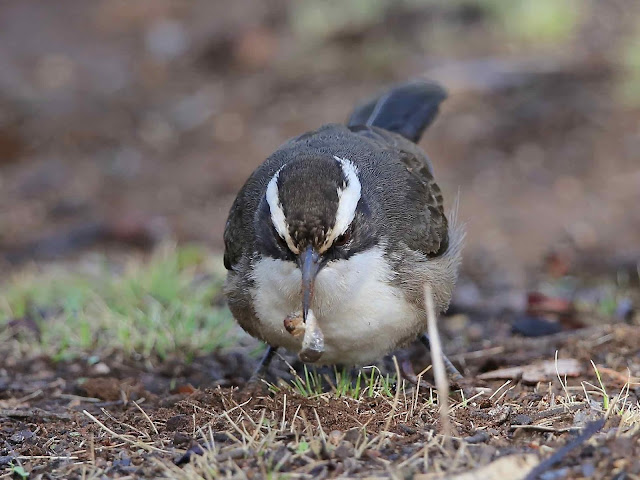We camped
on the Corni Paroo Waterhole in Currawinya NP for a few days. Once again the
country is experiencing a severe drought with Ramsar listed wetlands Lake Wyara
and Lake Numalla both dry. The waterholes along the Paroo River held water
though the water-bird numbers were very low with only a few Pelicans,
White-faced and White-necked Herons and a lone Black-fronted Dotterel seen.
The
dominant eucalypt species along the waterholes of the Paroo are River Redgum,
Black Box, Coolibah and Yapunyah (Eucalyptus
ochrophloia).
 |
| A Yapunyah growing on banks of the Paroo River alongside River Redgum and Coolibah. Their form varied from large single trunked trees to mallee like forms. |
Fortunately
the yapunyah was in flower and attracted Spiny-cheeked Honeyeater (the most
numerous honeyeater we saw), White-plumed Honeyeaters, Yellow-throated miners,
Black-faced Woodswallows and Australian Ringneck Parrots.
 |
| Spiny-cheeked Honeyeater in flowering yapunyah. |
 |
| Spiny-cheeks are widespread across much of arid inland Australia. |
 |
| Black-faced Woodswallows are another arid land nomadic species sometimes found in large numbers. They can often be seen feeding on nectar bearing flowers. |
 |
| White-plumed Honeyeaters are possibly the most numerous and most often encountered honeyeater species on inland/outback water ways. |
 |
| The bird in the photo above grooming. |
The
following photos are of some other birds we found in Currawyinya NP.
 |
| There are not many places in Australia (excluding Tasmania) where you will not encounter a Willie Wagtail! |
 |
| White-faced Heron, Corni Paroo Waterhole. |
 |
| The Grey Butcherbirds, another hardy outback survivor in hard times. |
 |
| Male Crested Bellbird found feeding at The Granites – this is another hardy arid land species. |
 |
| Both plants and animals are in survival mode in much of outback Australia at present - conditions are extremely dry. |
The plant
in the above photo is Solanum ellipticum – Potato Bush – a hardy arid land
plant which appears to be struggling under the conditions.
 |
| A female Hooded Robin (plus a male nearby) fed on a barren rocky area below The Granites along with Southern Whiteface, Red-capped Robins and a Brown Treecreeper. |
 |
| Five Brolga were found on the water at Ten Mile Bore. |
 |
| Brolgas are very wary birds and hard to approach on foot. |
It is interesting to visit the outback during
extreme droughts to compare drought conditions with our previous visits during better
times. The downside is very few birds and dusty rough roads that have broken up
in many places making travel testing at times (the road from Bourke to
Hungerford was moderately bad). From Currawinya NP we headed north to Eulo and
east to Cunnamulla to visit Bowra Sanctuary for a few days.


























